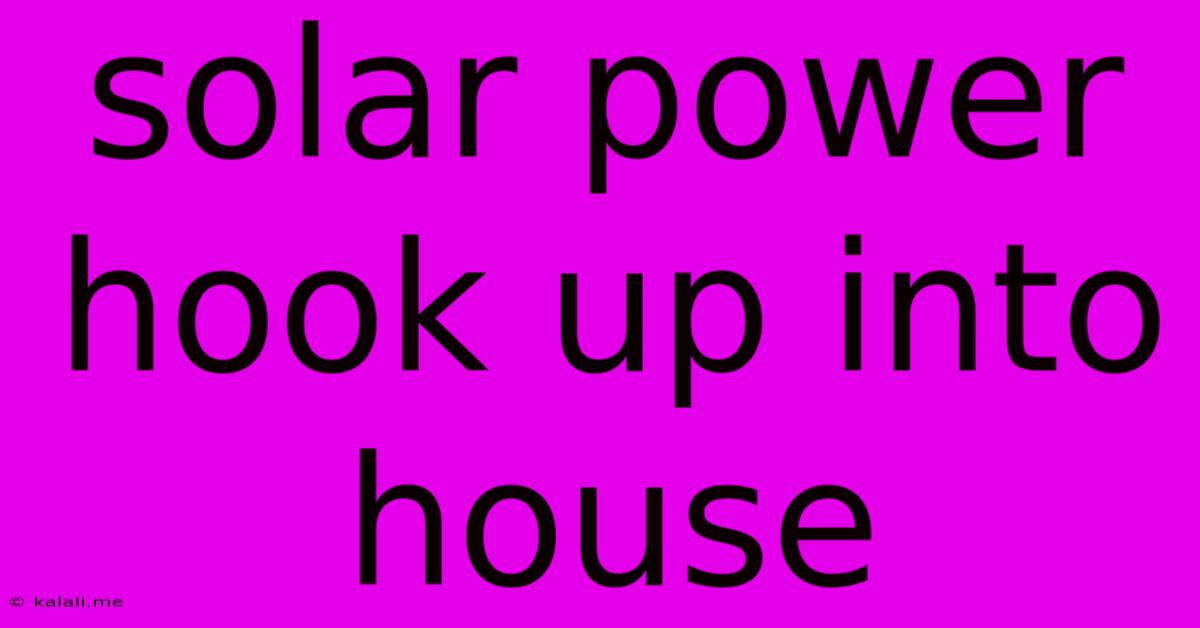Solar Power Hook Up Into House
Kalali
Jun 09, 2025 · 3 min read

Table of Contents
Connecting Solar Power to Your Home: A Comprehensive Guide
Meta Description: Learn how to connect solar power to your home, from system design and installation to permits and safety considerations. This guide covers everything you need to know for a successful solar energy integration.
Harnessing the power of the sun is becoming increasingly popular, and for good reason. Solar power offers a clean, renewable energy source that can significantly reduce your carbon footprint and electricity bills. But connecting a solar power system to your home isn't as simple as plugging in a lamp. This comprehensive guide walks you through the process, covering everything from initial planning to final connection.
1. Assessing Your Energy Needs and Solar Potential
Before you even think about solar panels, you need to understand your energy consumption. Check your electricity bills to determine your average monthly kilowatt-hour (kWh) usage. This figure is crucial for sizing your solar panel system appropriately. A professional solar installer can perform a site assessment to determine your home's solar potential, considering factors like roof orientation, shading, and available sunlight hours. This assessment will help determine the optimal size and placement of your solar panels for maximum energy generation. Consider factors like solar irradiance and roof space availability during this crucial phase.
2. Choosing the Right Solar Panel System
Several factors influence your solar panel system choice:
- Panel Type: Monocrystalline, polycrystalline, and thin-film panels offer varying levels of efficiency and cost.
- Inverter Type: String inverters are simpler and cheaper, while microinverters offer enhanced performance and monitoring capabilities. Consider the efficiency and durability of different inverter types.
- Battery Storage (Optional): Battery storage allows you to use solar energy even at night or during power outages. This adds significant cost but provides greater energy independence. Evaluate your need for energy storage based on your lifestyle and energy consumption patterns.
- System Size: The size of your system (measured in kilowatts, kW) should match your energy needs. Oversizing can be wasteful, while undersizing may not meet your requirements.
3. Obtaining Necessary Permits and Approvals
Connecting solar power to your home requires adherence to building codes and regulations. You'll need to obtain the necessary permits from your local authorities before starting any installation work. This process typically involves submitting plans for your solar panel system and undergoing inspections to ensure safety and compliance. Check with your local building department for specific requirements. Ignoring this step can lead to hefty fines or even force you to dismantle your system.
4. Professional Installation
While some homeowners attempt DIY solar installations, it’s highly recommended to hire a qualified and experienced solar installer. Professional installation ensures safety, optimal system performance, and warranty coverage. A reputable installer will handle all aspects of the installation, from panel mounting and wiring to connecting the system to your electrical grid. They’ll also handle all necessary interconnection agreements with your utility company.
5. Connecting to the Electrical Grid (Grid-Tie System)
Most residential solar systems are grid-tied, meaning they connect to your home's existing electrical system. This allows you to use solar power when available and draw from the grid when needed. The installer will connect the solar panel system’s output to your home's electrical panel through a special solar inverter. This inverter converts the direct current (DC) electricity generated by the panels into alternating current (AC) electricity compatible with your home's appliances.
6. System Monitoring and Maintenance
Once your solar panel system is installed, regular monitoring is crucial to ensure optimal performance. Many systems come with monitoring software that allows you to track energy production, identify potential problems, and optimize your system's efficiency. Periodic maintenance, including panel cleaning and inspection, will also help extend the lifespan of your system.
Connecting solar power to your home is a significant investment that offers long-term environmental and economic benefits. By carefully considering the factors outlined above and working with qualified professionals, you can ensure a safe, efficient, and successful solar energy integration for your home. Remember to prioritize safety throughout the entire process and always consult with qualified professionals for assistance.
Latest Posts
Latest Posts
-
Write An Equation For These Two Complementary Angles
Jul 01, 2025
-
How Do You Beat Bloxorz Level 7
Jul 01, 2025
-
How Old Are You If Your Born In 1992
Jul 01, 2025
-
How Many Quarts Are In 15 Gallons
Jul 01, 2025
-
How Many Ounces Are In A Bag Of Flour
Jul 01, 2025
Related Post
Thank you for visiting our website which covers about Solar Power Hook Up Into House . We hope the information provided has been useful to you. Feel free to contact us if you have any questions or need further assistance. See you next time and don't miss to bookmark.